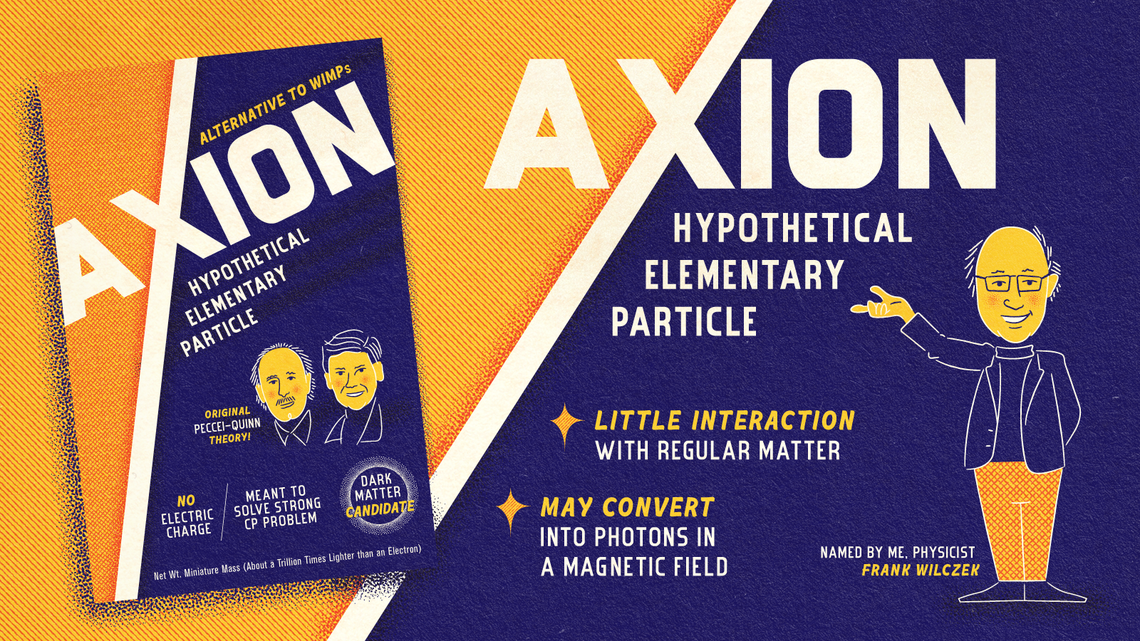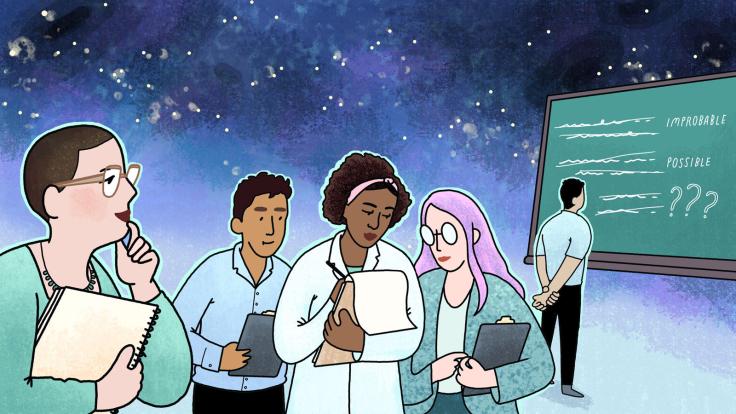In the early 1970s, physics had a symmetry problem. According to the Standard Model, the guiding framework of particle physics, a symmetry between particles and forces in our universe and a mirror version should be broken.
It was broken by the weak force, a fundamental force involved in processes like radioactive decay.
This breaking should feed into the interactions mediated by another fundamental force, the strong force. But experiments show that, unlike the weak force, the strong force obeys mirror symmetry perfectly. No one could explain it.
The problem confounded physicists for years. Then, in 1977, physicists Roberto Peccei and Helen Quinn found a solution: a mechanism that, if it existed, would cause the strong force to obey this symmetry and right the Standard Model.
Shortly after, Frank Wilczek and Steven Weinberg—both of whom went on to win the Nobel Prize—realized that this mechanism creates an entirely new particle. Wilczek ultimately dubbed this new particle the axion, after a dish detergent with the same name, for its ability to “clean up” the symmetry problem.

Several years later, the theoretical axion was found not only to solve the symmetry problem, but also to be a possible candidate for dark matter, the missing matter that scientists think makes up 85% of the universe but the true nature of which is unknown.
Despite its theoretical promise, though, the axion stayed in relative obscurity, due to a combination of its strange nature and being outshone by another new dark matter candidate, called a WIMP, that seemed even more like a sure thing.
But today, four decades after they were first theorized, axions are once again enjoying a moment in the sun, and may even be on the verge of detection, poised to solve two major problems in physics at once.
“I think WIMPs have one last hurrah as these multiton experiments come online,” says MIT physicist Lindley Winslow. “Since they’re not done building those yet, we have to take a deep breath and see if we find something.
“But if you ask me the thing we need to be ramping up, it’s axions. Because the axion has to be there, or we have other problems.”
Around the time the axion was proposed, physicists were developing a theory called Supersymmetry, which called for a partner for every known particle. The newly proposed dark matter candidate called a WIMP—or weakly interacting massive particle—fit beautifully with the theory of Supersymmetry, making physicists all but certain they’d both be discovered.
Even more promising was that both the supersymmetric particles and the theorized WIMPs could be detected at the Large Hadron Collider at CERN. “People just knew nature was going to deliver supersymmetric particles at the LHC,” says University of Washington physicist Leslie Rosenberg. “The LHC was a machine built to get a Nobel Prize for detecting Supersymmetry.”
Experiments at the LHC made another Nobel-worthy discovery: the Higgs boson. But evidence of both WIMPS and Supersymmetry has yet to appear.
Axions are even trickier than WIMPs. They’re theorized to be extremely light—a millionth of an electronvolt or so, about a trillion times lighter than the already tiny electron—making them next to impossible to produce or study in a traditional particle physics experiment. They even earned the nickname “invisible axion” for the unlikeliness they’d ever be seen.
But axions don’t need to be made in a detector to be discovered. If axions are dark matter, they were created at the beginning of the universe and exist, free-floating, throughout space. Theorists believe they also should be created inside of stars, and because they’re so light and weakly interacting, they’d be able to escape into space, much like other lightweight particles called neutrinos. That means they exist all around us, as many as 10 trillion per cubic centimeter, waiting to be detected.
In 1983, newly minted physics professor Pierre Sikivie decided to tackle this problem, taking inspiration from a course he had just taught on electromagnetism. Sikivie discovered that axions have another unusual property: In the presence of an electromagnetic field, they should sometimes spontaneously convert to easily detectable photons.
“What I found is that it was impossible or extremely difficult to produce and detect axions,” Sikivie says. “But if you ask a less ambitious goal of detecting the axions that are already there, axions already there either as dark matter or as axions emitted by the sun, that actually became feasible.”
When Rosenberg, then a postdoc working on cosmic rays at the University of Chicago, heard about Sikivie’s breakthrough—what he calls “Pierre’s Great Idea”—he knew he wanted to dedicate his work to the search.
“Pierre’s paper hit me like a rock in the head,” Rosenberg says. “Suddenly, this thing that was the invisible axion, which I thought was so compelling, is detectable.”
Rosenberg began work on what’s now called the Axion Dark Matter Experiment, or ADMX. The concept behind the experiment is relatively simple: Use a large magnet to create an electromagnetic field, and wait for the axions to convert to photons, which can then be detected with quantum sensors.
When work on ADMX began, the technology wasn’t sensitive enough to pick up the extremely light axions. While Rosenberg kept the project moving forward, much of the field has focused on WIMPs, building ever-larger dark matter detectors to find them.
But neither WIMPs nor supersymmetric particles have been discovered, pushing scientists to think creatively about what happens next.
“That’s caused a lot of people to re-evaluate what other dark matter models we have,” says University of Michigan theorist Ben Safdi. “And when people have done that re-evaluation, the axion is the natural candidate that’s still floating around. The downfall of the WIMP has been matched exactly by the rise of axions in terms of popularity.”

Searching high and low
In April 2018, after more than three decades of work, ADMX reached the needed sensitivity to detect the axion at its predicted mass. If axions do indeed exist, it could detect an axion any day.
It’s also been joined by a host of other experiments looking for axions across the possible mass range. At MIT, Lindley Winslow is running an experiment she and a team, including Safdi, developed called ABRACADABRA, which uses a doughnut-shaped magnet kept at temperatures just above zero.
With a magnet this shape, the magnetic field should run around the circle of the donut, but not inside, “where the Munchkin [doughnut hole pastry] comes from,” as Winslow puts it. But an axion interacting with this field would create a new field through the hole, which could be detected and could only be the sign of an axion.
“Unlike the experiments we build for the colliders, where they feel like something outside our normal everyday life, this would be funny in that we deal with electricity and magnets every day,” Winslow says. “We’d know that they’re having little axion interactions all the time.”
Another experiment called HAYSTAC, based at Yale, is looking for a heavier version of an axion using technology spun off from ADMX. The group is using a technique to minimize noise from quantum interactions, one that’s been used in only one other experiment, the Laser Interferometer Gravitational-Wave Observatory that in 2016 announced the first-ever detection of gravitational waves. It’s an example of how increasingly sophisticated technology is making axion detection more possible.
“The technological advancement in places like quantum information science, photon detection, these have seen big advancement,” says Reina Maruyama, a professor of physics at Yale who works on HAYSTAC. “These advances allow us to search for masses that are a factor of 10 bigger than where ADMX is looking.”
Axions that are emitted by nearby sources could also be discovered. The CERN Axion Solar Telescope, or CAST, uses X-ray detectors to turn a magnet into a telescope that searches for axions coming from the sun. And Safdi is studying a particular type of star called a neutron star—“the strongest magnetic fields in the universe,” he says—for the telltale signature of an axion converting into light.
Studying or even detecting the new particle would yield important insights into the nature of the universe itself. The specific properties of the particle could indicate whether it was created before or after the period of rapid cosmic inflation after the Big Bang, revealing information about the beginning of the universe. And because dark matter seeds the initial structure of a galaxy, the detection signal from an axion experiment would also contain crucial information about the formation of the Milky Way.
“Once we see an axion, we have the whole history of structure formation in our galaxy,” Rosenberg says. “So that is very exciting.”













